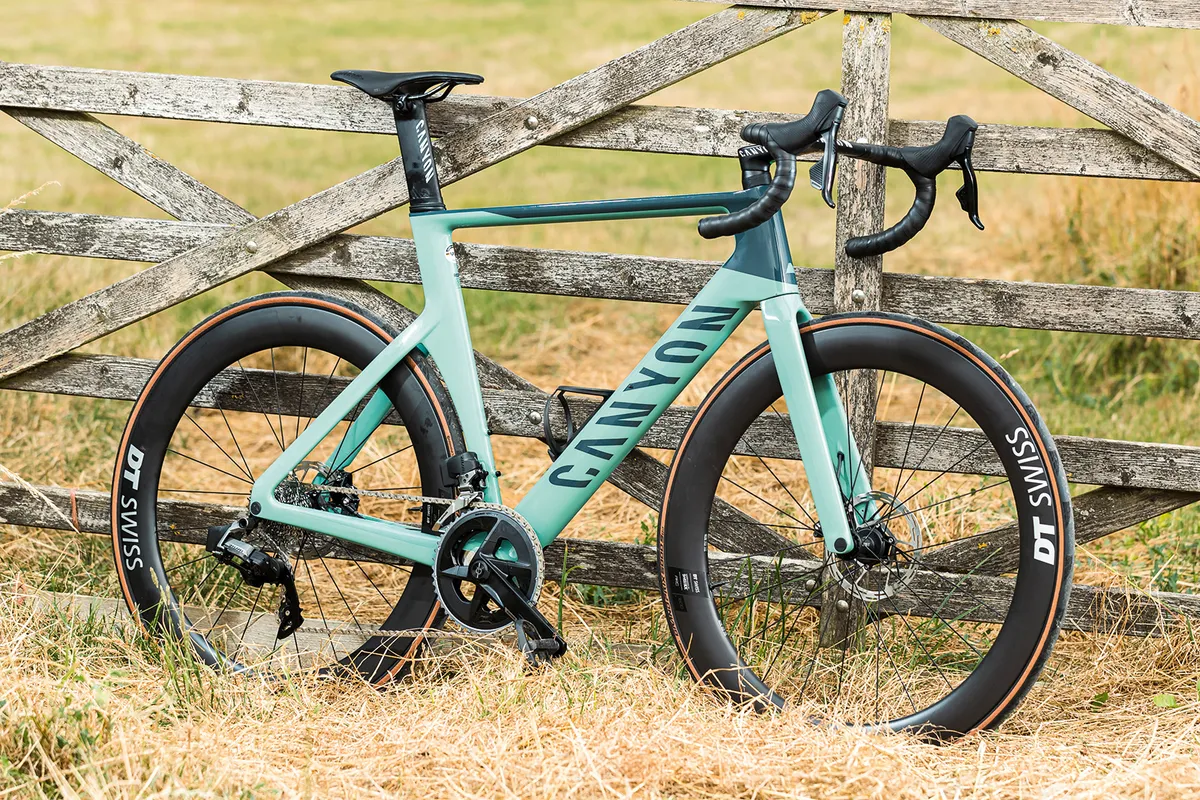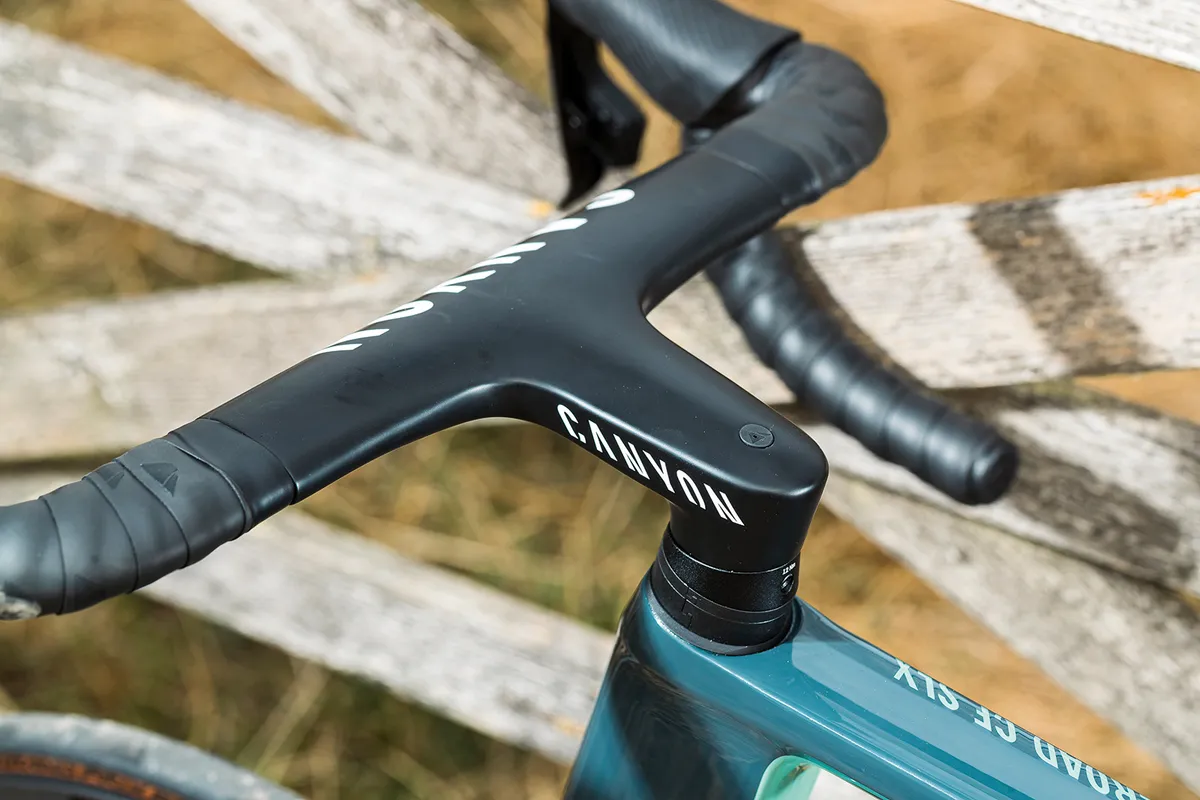The Canyon Aeroad CF SLX is a lightning-fast aero bike that offers a rapid ride, superb spec and enough practicality for everyday performance road riding.
While I admire the tech behind the best aero road bikes and like having a fast-blast session on one, I don’t want to have to live with that bike day-to-day.
The usual compromises for unabashed aero are increased weight, less comfort due to the torsional rigidity of the frame and integrated cables that can make the bike complex to maintain and travel with.
Then there’s the ride position, which is very low, long and uncompromising.
However, with this Aeroad, Canyon has confronted these issues.
Canyon Aeroad CF SLX frameset and handlebar

The Aeroad SLX may be the second-tier frameset (the CFR being the range-topper) but the deep oversized and aero-tubed frame weighs a competitively light 990g with its fully integrated design.
At 8.32kg complete (in a size large), it’s lighter than both the Trek Émonda SL 6 eTap and Vielo R+1 Alto I tested it alongside.
The frame sports the usual aero shapes we've come to expect, with deep tube profiles, bladed seatstays and a seat tube cutaway.
Frame aside, Canyon's take on the integrated cockpit is particularly interesting.
Integrated one-piece cockpits can be a pain to break down in order to fit in a bike bag, but the Aeroad’s SP0016 one-piece bar is actually a three-piece.
The bar is a new iteration of the CP0018 aero cockpit and Canyon has redesigned the bar's construction with newly reinforced carbon walls to improve stiffness and durability.

The stem and bar are formed from a single piece of carbon, but the width of the bar and the drops are separate pieces that slot into place and are secured by four T25 bolts.
Undo these sections and the bars fold down, making the bike narrower and easier to pack.
I loved the SP0016 bar for a different reason. On a size-large bike, the stem is 110mm, but the bar has three bolt-in positions, enabling you to adjust the width from 390mm up to 430mm.
The fashion is to run super-narrow bars, but it doesn't work for me. Here, however, you can tweak things.
So if you want to keep things narrow, like the pros, you can. If your position on the bike requires a wider bar, then that's an option, too.
Canyon Aeroad CF SLX geometry
The Aeroad has adopted Canyon’s updated Pro geometry (the new Canyon Ultimate now also uses a very similar geometry), which means my large test bike has a 580mm stack height and 401mm reach.
That’s racy low, and reasonably long, but not overly so: the previous 2018 model had a 16mm longer reach.
It’s also combined with a short 1,006mm wheelbase and reasonably racy 73.25-degree head and 73.5-degree seat angles. I found I was happy to ride for as long as my legs could take me.
In short, it's a racy but well-balanced position, with the caveat, as ever, that it needs to work for your requirements and flexibility as a rider.
| | XXS | XS | S | M | L | XL | XXL |
|---|---|---|---|---|---|---|---|
| Seat angle (degrees) | 73.5 | 73.5 | 73.5 | 73.5 | 73.5 | 73.5 | 73.5 |
| Head angle (degrees) | 70.5 | 71.5 | 72.75 | 73.25 | 73.25 | 73.25 | 73.75 |
| Chainstay (mm) | 410 | 410 | 410 | 410 | 410 | 410 | 410 |
| Seat tube (mm) | 443 | 473 | 503 | 533 | 563 | 593 | 623 |
| Top tube (mm) | 520 | 533 | 549 | 559 | 572 | 598 | 613 |
| Head tube (mm) | 89 | 109 | 126 | 147 | 167 | 193 | 211 |
| Bottom bracket drop (mm) | 72 | 72 | 70 | 70 | 70 | 70 | 70 |
| Wheelbase (mm) | 972 | 977 | 984 | 989 | 1,002 | 1,025 | 1,038 |
| Standover (mm) | 733 | 759 | 785 | 810 | 834 | 860 | 884 |
| Stack (mm) | 498 | 521 | 539 | 560 | 580 | 606 | 624 |
| Reach (mm) | 372 | 378 | 390 | 393 | 401 | 419 | 429 |
| Crank length (mm) | 165 | 170 | 172.5 | 172.5 | 175 | 175 | 175 |
Canyon Aeroad CF SLX performance

On the road, the Aeroad is simply stunning.
It’s devastatingly rapid over rolling terrain, feels responsive to pedal inputs, and the frame and fork do a great job of reducing fatiguing vibrations from poor road surfaces.
Once up to speed, it holds onto it tenaciously.
Over the same 4.5-hour test route as the brilliant Trek Émonda, my average speed was up by more than a mile per hour for the same power output.
There are other factors at play, of course, but the bottom line is the Aeroad is one seriously efficient ride.
Out of the saddle, the frame feels taut and responsive, making it a very able climber, though it made an occasional irritating swooshing scrape of the front disc rotor when I was out of the saddle.
After thoroughly cleaning the bike, rotors and pads, and realigning the brake, I didn’t get any repeat of the scraping during the test period, so I can put that down to a setup issue.
Rubbing disc brakes are fairly common but, given Canyon is a direct-to-consumer brand with no immediate shop support, setup niggles such as this are something to consider when buying a bike online.

While the Aeroad could never be described as an endurance road bike, it’s leagues above its harsh-riding predecessor.
My colleague, Simon von Bromley, noted in his Canyon Aeroad CFR review that the front end suffered from some harshness, but it's not something I've experienced here.
The CF SLX is made from a more modest carbon fibre than the CFR, which may help (Cannondale's top-end Hi-Mod frames are noticeably stiffer than the 'standard' carbon models, for example), while the DT Swiss ARC 1600 wheels specced on this model have a 20mm internal rim width (compared to 17mm on Simon's bike).
Canyon continues to spec a 25mm Continental GP5000 S tubeless tyre on the front and a 28mm tyre on the rear, so the frontal area is narrow and aero, yet the back has a little more volume to help smooth out the road. Both tyres plump up when inflated to do their bit in terms of ride quality.
Kudos, too, to Canyon for speccing one of the best road bike tyres on the market. It's an area where many brands cut corners.

On that note, the Aeroad SLX’s component listing is impressive from top to bottom.
It gets the full SRAM Rival AXS groupset replete with the power meter, those 50mm-deep, carbon fibre and tubeless-ready DT Swiss ARC 1600 aero wheels (which alone retail at £1,699), a Selle Italia SLR Boost saddle, carbon bars and a carbon seatpost.
Canyon Aeroad CF SLX bottom line

In all, the Aeroad has just about changed my opinion of the aero road bike.
The carefully considered, holistic design makes it light enough, easy to ride and relatively comfortable for long, fast-paced rides.
Maybe, just maybe, the next bike on my want list will be an aero bike.
Product
| Brand | canyon |
| Price | 7399.00 AUD,4999.00 EUR,4949.00 GBP |
| Weight | 8.3200, KILOGRAM (L) - |
Features
| Fork | FK0060 CF all carbon |
| br_stem | Canyon CP0018 aero carbon cockpit |
| br_chain | SRAM RIVAL D1 12-speed |
| br_frame | Carbon |
| Tyres | Continental GP 5000s 28c |
| br_brakes | SRAM Rival, 160mm Paceline rotors |
| br_cranks | SRAM Rival AXS with power meter and 48/35t chainrings |
| br_saddle | Selle Italia SLR Boost Superflow S manganese |
| br_wheels | DT Swiss ARC 1600 carbon |
| br_shifter | SRAM Rival eTap |
| br_cassette | SRAM XG-1250 10-30t 12-speed |
| br_seatpost | Canyon SP0046 Aero |
| br_handlebar | Canyon CP0018 aero carbon cockpit |
| br_bottomBracket | SRAM DUB BB86 |
| br_availableSizes | 2XS, XS, S, M, L, XL, 2XL |
| br_rearDerailleur | SRAM Rival eTap |
| br_frontDerailleur | SRAM Rival eTap |

